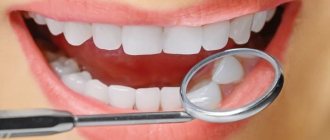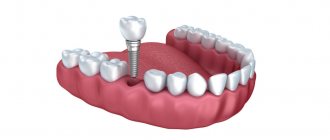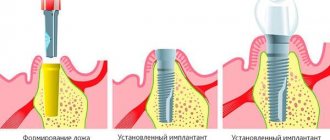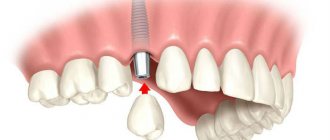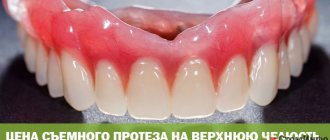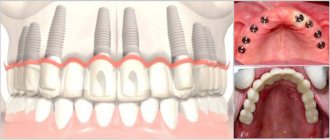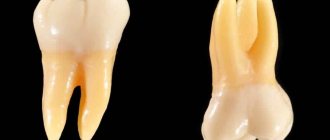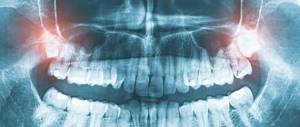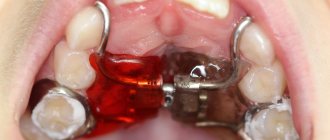Faced with the need to restore damaged or lost teeth, we are faced with choosing not only a prosthetic technique, but also a material for making the prosthesis. It can be metal, plastic, ceramic or a combination of these. Which material is better? Valery Borisovich Sokhov, an implantologist and orthopedist at Vimontale Dentistry in Moscow, talks about all the pros and cons of the most popular metal-ceramic prostheses and the increasingly widespread ceramic prostheses.
What is a metal-ceramic crown?
Today, the choice of materials for making dental crowns is very wide: ceramics, zirconium dioxide, and plastic, but metal-ceramics continues to be the most popular and affordable. At the moment, metal ceramics are a kind of gold standard in dentistry, since similar designs have been used by doctors for many years and have proven themselves to be good.
Metal-ceramic crowns are a “cap” with machined fissures, which is placed on a ground tooth and completely imitates its shape, including all anatomical formations. The basis for the structure is a metal frame, which is covered on top with a layer of ceramics, indistinguishable in color from natural enamel. The prosthesis is secured to the ground dental tissues using special composite or glass ionomer cement. In case of severe destruction, a metal tab is first installed, which serves as a reliable basis for the crown. Metal-ceramics are also used for the manufacture of bridges and clasp dentures supported both on the patient’s own teeth and on dental implants. In the latter case, the use of implants with metal abutments is recommended.
Prices
Installing a metal-ceramic prosthesis allows you not only to restore aesthetics, but also to get strong and reliable teeth. Here is a complete analysis of prices, which consist of the cost of the metal used, the equipment used and the status of the dental clinic.
If we consider the average cost, then installing a prosthesis made of ordinary metal and locally produced ceramics will cost somewhere around 4,000 rubles
.
When using European ceramics and high-quality alloy, a crown will cost an average of 6,000 rubles. The prosthesis, made of precious metals, has a price of 15,000 rubles. and higher.
When visiting a dentist to restore your dentition, you should also take into account the cost of concomitant treatment, which is determined by the doctor after an examination.
When carrying out the prosthetic procedure, you will need to install a temporary version of crowns made of plastic, the cost of which is added to the main amount. Their price is on average 1000 rubles per crown.
Pros and cons of a metal-ceramic crown
Among the advantages of metal-ceramic crowns is, first of all, their strength. Therefore, in most cases they are installed on chewing teeth. Undoubtedly, they look much better than purely metal crowns. In general, metal-ceramic crowns imitate real teeth well, but with the advent of new materials in prosthetics, preference in restoring anterior teeth began to be given to all-ceramic structures. When a combination of reliability and aesthetics is needed in the chewing area, then the best choice would be ceramic prostheses based on zirconium dioxide.
Application
Metal crowns, often coated, are used to restore chewing teeth. They can withstand chewing stress very well. And its location in an area invisible to others does not require increased aesthetics.
Before installing such a structure, the tooth is prepared so that the prosthesis does not protrude from the dentition.
Crowns have the following advantages:
- low cost;
- reliability;
- high strength;
- the ability to protect the remaining tooth from external influences and strengthen it.
One of the disadvantages of metal products is insufficient aesthetics. But today this problem is being combated with the help of gold or white coating, which makes teeth more attractive.
And cast products made using modern technology are of the highest quality.
What are the differences between metal-ceramic crowns?
Indeed, many patients wonder: what is better - zirconium crowns or metal-ceramics? Roughly speaking, both structures are metal-ceramic, but zirconium is a “white” material that does not shine through the ceramic, as sometimes happens with ordinary metal. Therefore, today ceramic crowns on a zirconium frame are close in aesthetic qualities to all-ceramic crowns, but at the same time they have the same strength as metal-ceramics. However, prices for such prostheses are higher than for metal-ceramic structures without the use of zirconium.
The question of which is better - metal-ceramic or ceramic crowns cannot be answered unequivocally. The choice is made depending on the indications and budget. So, if prosthetics of the frontal group of teeth is necessary, it is recommended to choose solid ceramics. It is aesthetic metal ceramics. Typically, such crowns are placed on teeth where the chewing load is less, since the metal-ceramic frame is stronger. Regarding the issue of price, a metal-ceramic crown is, of course, cheaper.
Possible complications
Since prosthetics is a procedure with a direct effect on the tooth and periodontal tissue, in some cases complications and discomfort may occur.
The most common complication is gum inflammation
which can be damaged by the prosthesis. This situation requires adjustment or complete replacement of the crown. Discomfortable manifestations are expressed by a slight aching pain and an unnatural perception of the teeth.
These sensations are intermittent and last no more than a week. If these symptoms manifest themselves much longer than expected, you should consult an orthopedist.
Types of metal-ceramic crowns
Metal-ceramic crowns have several classifications: according to the frame material and according to the ceramic material. Thus, according to the frame material, crowns are distinguished based on a chromium-nickel alloy, based on a cobalt-chromium alloy, and based on a gold-platinum (palladium) alloy (based on the so-called “noble alloys”). There is also another material that is used quite rarely - titanium alloy. Each of these types of metal-ceramic crowns has its own pros and cons. Traditionally, the most popular material is cobalt-chromium alloy. Based on the ceramic material, a distinction is made between conventional (high-temperature) and low-temperature ceramics. Low-temperature ceramics based on “noble” alloys look more aesthetically pleasing.
Indications and contraindications for metal-ceramic crowns
The indications for installing a metal-ceramic crown are the same as for crowns made of other materials. The main one is the index of destruction of the coronal surface of the tooth, equal to 0.6. Also, indications for installing a metal-ceramic crown are:
- any non-carious lesions, for example, fluorosis or enamel hypoplasia;
- abnormal development and position of the front teeth in adults, which for any reason cannot be eliminated by orthodontic methods;
- pathological abrasion or wedge-shaped defect;
- aesthetic defect in the crowns of natural teeth (changes in color and shape, loss of shine, etc.);
- inconsistency of existing artificial crowns with aesthetic and functional requirements;
- metal-ceramic crowns can also be used as a splinting structure for mild to moderate periodontitis;
Each of the above indications should be considered in the context of a specific clinical case. Contraindications include, for example, bruxism, as well as periodontitis, accompanied by severe tooth mobility. In addition, fixed prosthetics on implants also involves the use of metal-ceramic crowns.
Is it possible to put metal-ceramic crowns on the front teeth?
It is possible if the patient’s budget does not allow for all-ceramic crowns. There are no medical contraindications to the manufacture of metal-ceramic crowns on the frontal teeth. However, aesthetics in this case recedes into the background. Such crowns will not look very natural. Therefore, it is still better not to place metal-ceramic crowns on the front teeth.
Installing a metal-ceramic crown on a tooth
- The first stage of installing a metal-ceramic crown can be called clinical. The doctor treats the tooth and its canals, prepares dental tissue for the future crown and takes an impression.
- After this, the laboratory stage begins: in the laboratory, a crown frame is made, which we then try on, check its reliability and fit to the tooth, correct defects, if any, and also choose the color of the future structure. The frame is then taken back to the laboratory, where a technician applies ceramic paste to it.
- When the crown is ready, the doctor invites the patient to an appointment and installs it.
While the prosthesis is being manufactured, which can last from one to two weeks, a temporary crown is installed on the tooth.
Metal-ceramic crown with shoulder
There are no metal-ceramic crowns with a shoulder. The tooth is ground with a shoulder, and the metal-ceramic crown is made with a ceramic shoulder. That is, the edges of the metal frame of the crown are lined with a special “shoulder” ceramic mass. This is done to improve the aesthetics of prosthetics with metal-ceramic crowns, as well as to prevent “cyanosis” (translucency of the metal frame) in the crown-tooth transition zone.
Manufacturing procedure
The production of a crown of this type takes place in 5 stages in a laboratory:
- First, the dentist takes impressions of the prosthetic area and delivers it to the laboratory.
- Using these casts, a model is formed, from which the metal frame of the prosthesis is cast. The standard base thickness varies from 0.3 to 0.5 mm.
- After casting, the model is ground and treated with a substance that increases adhesion.
- A ceramic solution is applied layer by layer onto a prepared metal alloy base. Each layer is fired in a furnace heated to 950 degrees. This gives the ceramic surface high strength.
- After all stages, the surface is ground and polished to give the crown a natural look.
Service life of metal-ceramic crowns
How long does a metal-ceramic crown last? Modern products last on average about 10 – 12 years. If a chip occurs on the metal-ceramic crown of the ceramic layer, then in some cases repair is possible. If it did not occur due to the development of secondary caries under the prosthesis, but as a result of mechanical damage, the dentist assesses the volume of the chip and, if the metal frame is not exposed, restoration of the metal-ceramic crown can be carried out using grinding or composite materials. If a serious chip occurs on the metal-ceramic crown, the prosthesis must be replaced.
Once the service life of the prosthesis has expired, the structure must be replaced. This is due to the fact that the special cement on which the structure is attached begins to deteriorate over time under the influence of saliva and other factors. If the crown is not removed in time, a problem may arise such as secondary caries, developing under the cap and at its junction with the tooth tissue.
Guarantee
As with any other types of dentures, each clinic provides a guarantee for metal-ceramics for teeth. Of course, its duration is short, and how long the guarantee for metal-ceramics lasts depends mainly on the decision of the management of dentistry. What kind of warranty is usually provided? This is a period of one to three years during which you can see a doctor for free repairs to your prosthesis. Considering that structures made from this material are recommended to be replaced after 5-7 years, such a guarantee can be called acceptable.
Make an appointment
right now!
Sokhov Valery Borisovich
Surgeon, Therapist, Orthopedist, Implantologist
Caring for metal-ceramic crowns
The rules for caring for metal-ceramic crowns are practically no different from the rules for caring for natural teeth. However, less interdental plaque and tartar are formed on the metal-ceramic surface than on natural enamel. For care, it is necessary to use dental floss, brushes and, preferably, an irrigator to avoid the accumulation of plaque at the transition boundary from the crown to the tooth. During the professional hygiene procedure, the structure must be polished. Otherwise, timely attendance at preventive examinations and thorough daily cleaning will help the metal-ceramic crown serve its full service life.
How much do metal-ceramic crowns cost in Moscow?
The price of metal-ceramic crowns per tooth depends on the price category of the clinic in Moscow, the metal used to make the frame, the qualifications of the prosthetist and dental technician, the complexity of the clinical case and a number of other factors. The price of a metal-ceramic crown for one tooth starts from 7,000 rubles. However, it does not include additional costs. The total cost of a dental crown made of metal ceramics, including taking impressions, installing a temporary crown and fixing a permanent one, is about 10,000 rubles, which, in general, is very inexpensive in Moscow.
Manufacturers
The price lists of dental clinics offer products from the following manufacturers:
- Noritake - metal-ceramic crowns from the Japanese company Kuraray Noritake Dental Inc, produced using the CAD/CAM method. The products are distinguished by high manufacturing precision and elegance.
- Vita metal-ceramic crowns are produced in Germany; production has been in operation since 1962. During manufacturing, emphasis is placed on strength qualities, which are achieved through the use of a finely dispersed coating.
- Duceram are metal-ceramic crowns made in Germany, which was one of the first to occupy this niche and continues to improve its product. The main feature of the manufactured prostheses is a reasonable price-quality ratio.

